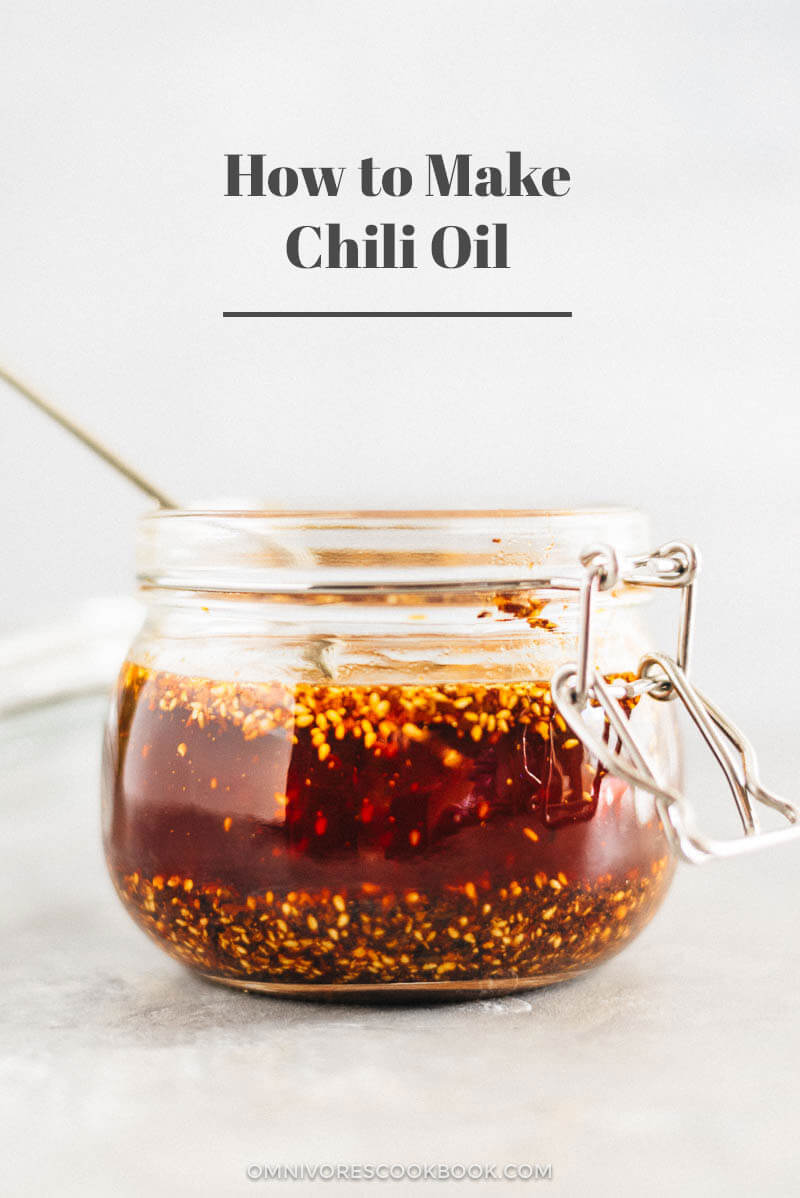
Chili oil is such an important staple for Chinese families, equal to soy sauce and vinegar. For many Chinese people chili oil is as important as ketchup is to American people. It always shows up on tables of small diners, no matter whether it’s a dumplings or noodle place. Once you’re hooked, you’ll want to pour it on everything.
Whenever I’m talking about chili oil, I always refer to homemade chili oil. It tastes ten times better than the store bought product, lasts just as long if you store it in the fridge, and does not contain additives or MSG. There is this fresh aromatic nuttiness that bottled chili oil never delivers.
Plus, when you use chili oil like a Chinese person, you gotta mix in the chili flakes as well. The chili flakes are well toasted when you cook the chili oil, so they taste less spicy but quite smoky with a crispy texture. When mixing with noodles, these tiny umami bits coat the ingredients evenly and each bite releases waves of piquant zing to your taste buds. It’s as exciting as throwing a handful of Pop Rocks in your mouth!
When I cook Vegetable Chow Mein, Lanzhou Beef Noodle soup, and hearty Sesame Noodle Salad, I’ll always spoon a few dollops of chili oil mixed with thick chili flakes onto my finished dish. This one small action will elevate your cooking from mundane to heavenly.
Cooking process
The process might look intimidating at first, but you won’t believe how easy it is once you try it. There are three steps involved.
(1) Combine chili flakes with aromatics of your choice in a heatproof bowl.
A ceramic bowl is my go-to choice. If you plan to use a glass jar, make sure it is heatproof. We will be dealing with hot oil in the next step. Using glassware might cause the glass to shatter and can be very dangerous.
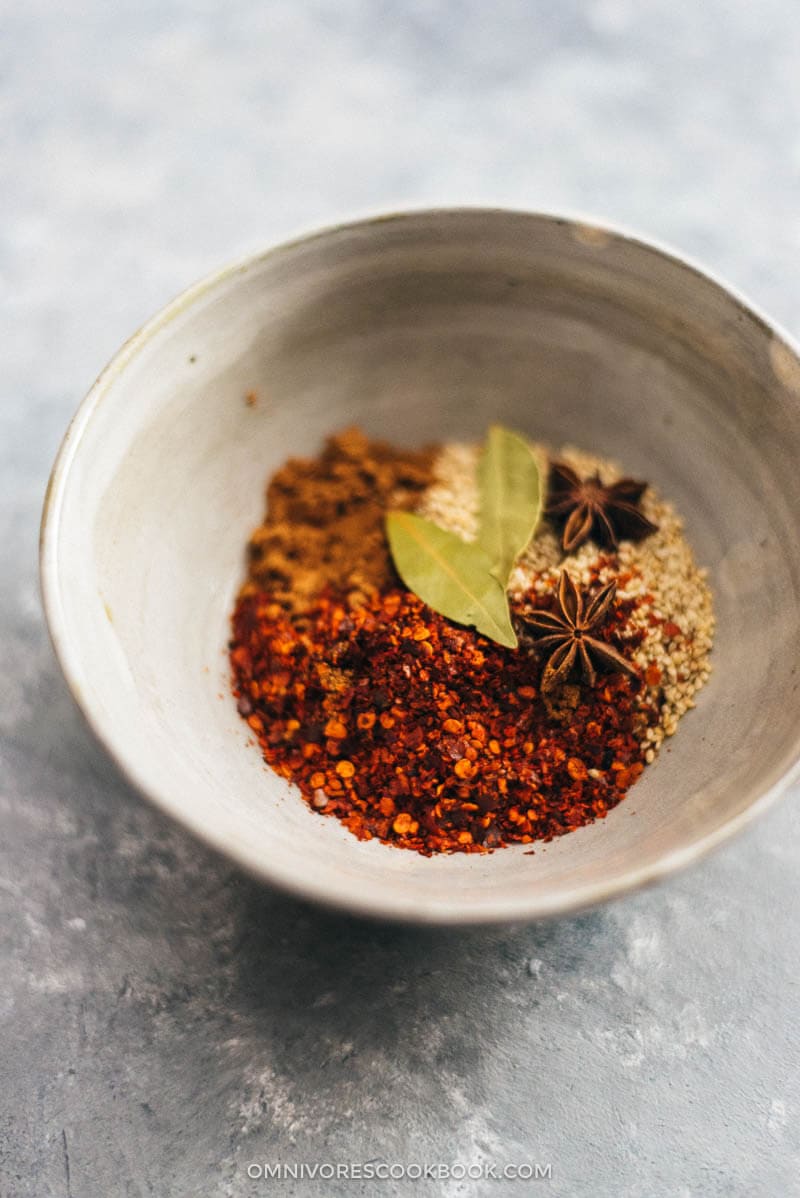
(2) Heat the oil until it reaches 370 degrees F (190 C).
The key to making delicious chili oil is to heat the oil hot enough without overheating it. The hot oil will cook the spices thoroughly and be infused with various flavors. However, if the oil is too hot, it will burn the pepper flakes and sesame seeds, and the resulting chili oil will be bitter in taste.
The best way is to use an instant thermometer to monitor the oil. If you do not have a thermometer, I also introduce a “ginger method” in the recipe below, which is a good indicator of the oil temperature.
Select a small saucepan that has long handle and is good for pouring. Alternatively, you can also use a ladle to transfer the oil.
(3) Pour oil into the bowl with chili flakes.
The oil will bubble fiercely at first and quickly cook the chili flakes. Simply mix everything together with a spoon and let the oil sit until cooled down.
That’s it! Now you have a jar of delicious chili oil to use to create an authentic Chinese flavor.
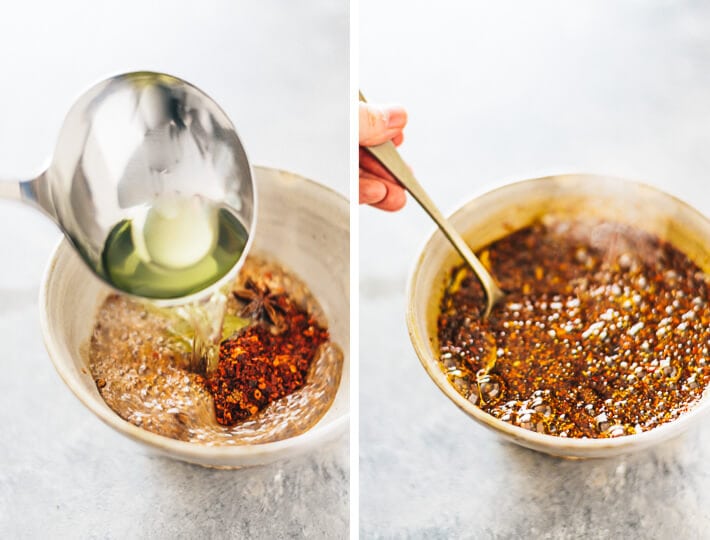
More cooking notes
(1) What types of chili flakes should you use?
The best option is to use fresh chili flakes imported from Sichuan. This type of chili flake is made with premium chili peppers of a vibrant red color. The blend also contains fewer seeds, so your chili oil won’t end up overly spicy.
The next best option is using Korean chili flakes. With these, I found my chili oil doesn’t have the brightest red color, but it doesn’t affect the taste.
(2) How do you make chili flakes?
You can use whole dried chili peppers to make chili flakes too. Lightly toast the peppers in a pan until the pepper turns a bit darker, and grind the peppers into chili flakes. To make sure the oil won’t turn out too spicy, cut open half of the hot peppers with kitchen shears and discard the seeds.
(3) What types of aromatics should you use in the chili oil?
The answer is, you can use many types of aromatics or none at all. The flavor is totally up to personal preference. In China, each region down to each family has their own formula to make their favorite chili oil.
To make the most basic chili oil, you can simply use chili flakes. Some versions use ginger, cinnamon bark, bay leaves, star anise etc.
The recipe below is our family’s formula. We always enjoy adding a few Sichuan peppercorns to add a hint of numbing nuttiness. We also use a pinch of five spice powder to add umami.
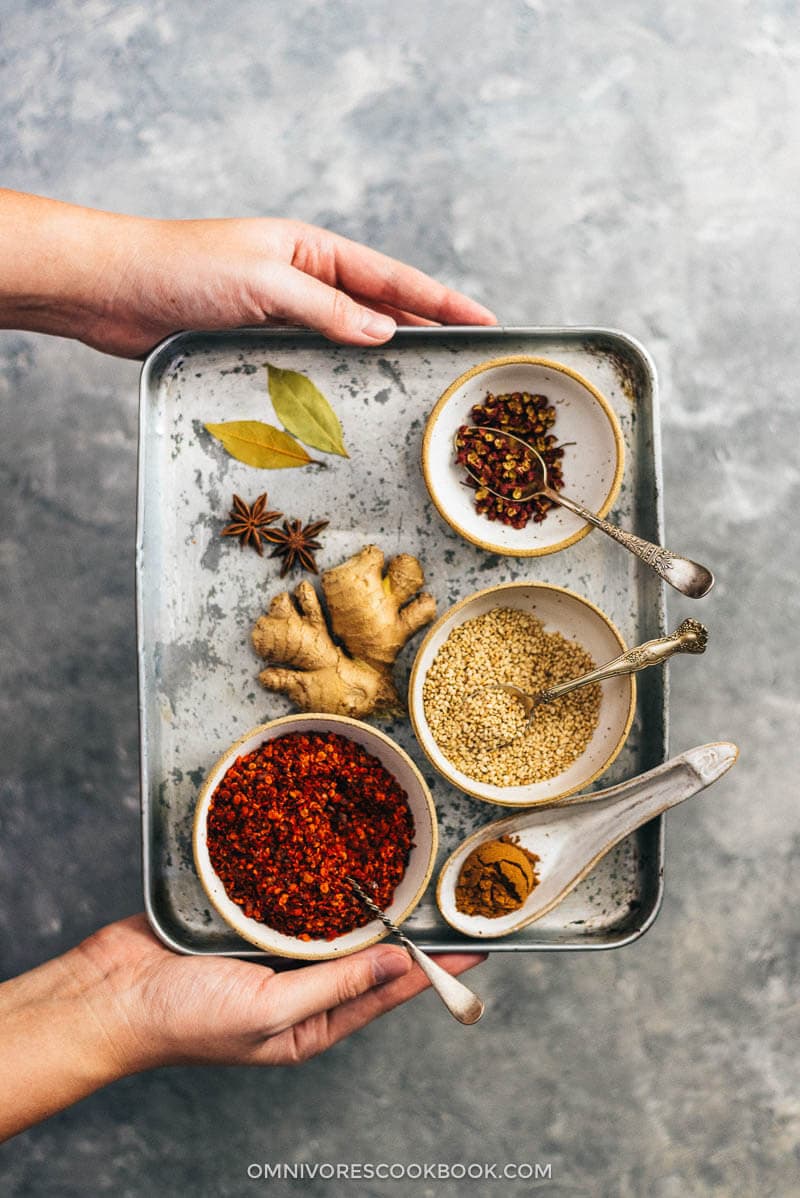
(4) To filter or not to filter the chili flakes?
Once you’ve made the chili oil, you can either filter the oil and discard the chili flakes, or you can leave them in. This habit varies a lot in China depending on the region, so I’d say both methods are authentic and correct.
As a northerner, I grew up having chili oil with tons of chili flakes sitting at the bottom. In fact, in many restaurants you will find the chili oil jar is filled mostly chili flakes and very little oil.
Again, if you choose proper chili flakes (see point #1 above), your chili oil will not be very spicy and it should taste nutty with a balanced umami flavor. The chili flakes should add texture and smokiness to your dish, not spiciness.
How to use chili oil
- Make authentic Sichuan food: Mapo Tofu, Sichuan Spicy Wonton in Red Oil, Sichuan Sliced Beef in Chili Sauce (Fu Qi Fei Pian), Bang Bang Chicken
- Drizzle on soup to make them taste better immediately: Wonton Soup, Instant Pot Chicken Noodle Soup, 15-Minute Curry Ramen with Leftover Ham
- Make a simple cold dish taste irresistible: Real Deal Sesame Noodles, Cucumber Salad
- Use it on congee and oatmeal: 5-Ingredient Savory Oatmeal (Chinese-Style)
- Use it on your roast veggies to add tons of flavor (extremely helpful if you follow a vegetarian or vegan diet)
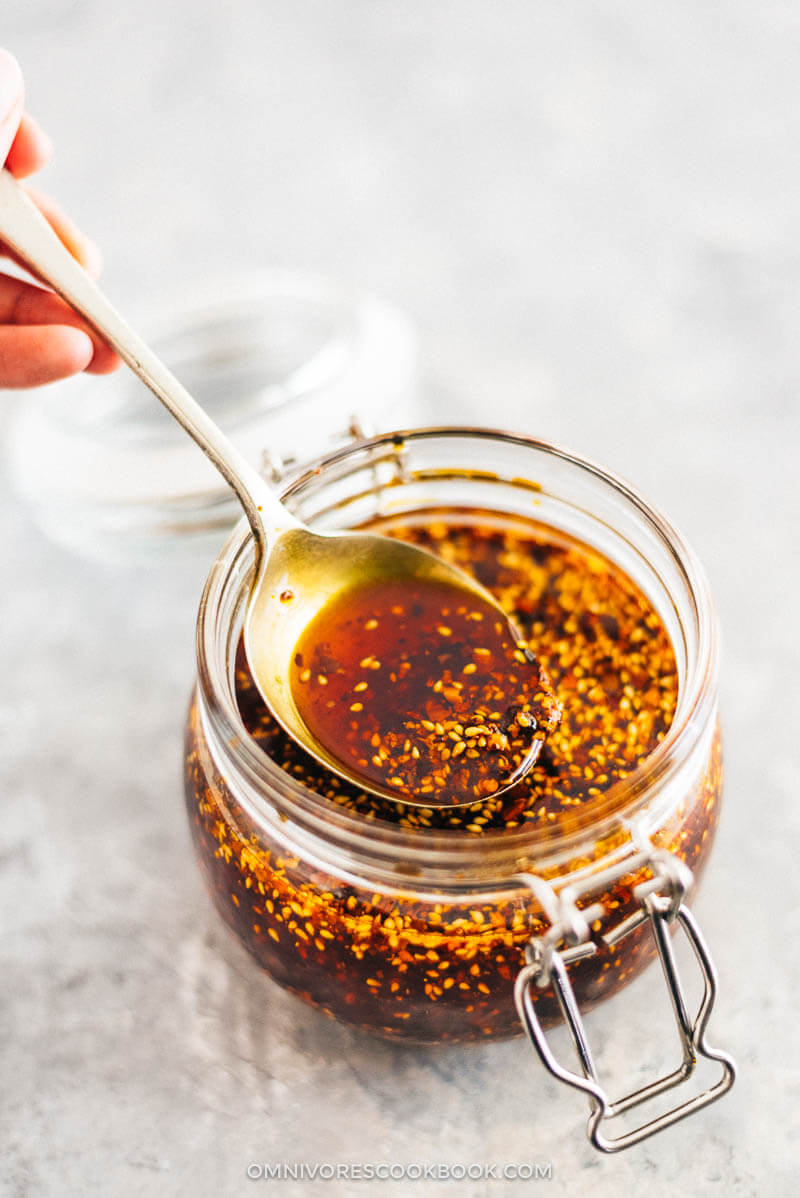
Other homemade Chinese sauces & condiment
- Chinese BBQ Sauce
- Chinese Flavored Sweet Soy Sauce
- Vegetarian Oyster Sauce
- Homemade Black Bean Sauce
If you give this recipe a try, let us know! Leave a comment, rate it (once you’ve tried it), take a picture and tag it @omnivorescookbook on Instagram! I’d love to see what you come up with.
Chinese Cooking Made Easy
Are you new to this website? This free email series is a great place to start. I’ll walk you through a few of my most popular recipes and show you how and why they work. You’ll quickly start to cook better Chinese food in your own kitchen.
Watch video
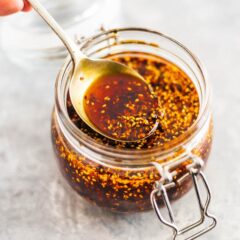
How to Make Chili Oil (辣椒油)
Ingredients
- 4 tablespoons Chinese chili flakes (*footnote 1)
- 2 teaspoons five spice powder
- 3 tablespoons toasted sesame seeds
- 1 teaspoon ground Sichuan peppercorn
- 1 whole star anise (Optional)
- 2 bay leaves
- 1 cup vegetable oil (or grapeseed oil)
- 1 piece thinly sliced ginger (Optional)
Instructions
- Combine chili flakes, five spice powder, sesame seeds, star anise, Sichuan peppercorns, and bay leaves in a heatproof ceramic bowl that can hold at least 2 cups liquid. Place the bowl on a heat resistant coaster.
- Heat oil in a wok (or a skillet) over medium-high heat. Add ginger. When the ginger starts to wither and turns golden brown, immediately turn off the heat. The oil should reach 370 degrees F (190 C) and no higher than 400 F (200 C) if read with an instant thermometer.
- Carefully pour oil or use a ladle to transfer oil into the bowl of mixed spices. The oil will bubble for a few seconds and cook the spices. While the the oil is bubbling, use a metal spoon to stir gently to mix the spices, so they’ll cook thoroughly.
- When the oil cools down a bit, scoop out and discard the star anise and bay leaf.
- The oil is now ready to use! Its flavor will mature if you let it rest for a day, allowing the spices to infuse into the oil.
- The oil can be stored covered at room temperature for two weeks, or up to six months in the fridge in an airtight container.
Notes
Nutrition

Did you make this recipe?
I’d love to hear how it turned out for you! Please take a moment to leave a 5-star rating ⭐️ and share your thoughts in the comments further down the page. It really helps others discover the recipe too.
The recipe was originally published on August 7, 2014, and updated on April 23, 2017.

Ida
Came out great. Ginger method very helpful. Thank you.
Ida
Hello, I am about to try this. However I have schizuan ground pepper instead of peppercorns. Do I use the same quantity? Thank you for your help.
Spire
Suggest using half when ground. Make your oil. Use a metal spoon which will cool a couple of drops so you can taste it. If you feel like you want more, then you can add more.
Robin
So that’s how it’s done! I am so happy I found your site.
I have long been a fan of Chinese Cooking but really didn’t understand how to re-create some of my favorite dishes at home.
Thank you so much for all your work to compile these wonderful recipes.
Dave B
I’m having trouble finding the Sichuan chili flakes. You said it’s possible to substitute Korean chili flakes – do you mean gochugaru, which is used to make kimchi? Those are not very hot at all.
Maggie Zhu
Yes, you can use gochugaru. Chinese chili flakes is a tide spicier than gochugaru, but not by a lot. The chili oil should be very fragrant and not super spicy, so you can use quite a lot in a dish without making it too hot (Sichuan cooking usually requires extra chili pepper to add spiciness, on top of the chili oil). That being said, you can add a small amount of cayenne pepper to the gochugaru if you wish the chili oil is a bit spicier.
Guido Marsupio
When you say Korean chili flakes, do you mean gochugaru? The flakes that are used in kimchi? Doesn’t seem right because those have very little “hot” so maybe you mean something different.
Maggie Zhu
The Chinese chili flakes are the best ones to use (like this one). But if you cannot source Chinese chili flakes, I feel like Korean type is the next best option. Chinese chili flakes are not very spicy either. The oil is more fragrant than hot. And you can use quite a lot in a recipe without making a dish too spicy. If you want a slightly spicier chili oil, you can always experiment with using gochugaru plus a small amount (like 1/2 to 1 teaspoon) cayenne pepper.
CarmenL
May I ask if I can use olive oil in this recipe?
Thanks.
Maggie Zhu
I wouldn’t use olive oil because it has a very strong taste itself. Any neutral oil will work much better in this recipe than olive oil.
Alecia
Fantastic chili oil! Thx-
Dane Henas
I made this so I can make your steamed eggs with pork. It was extremely easy. I used two Le Creuset saucepans with spouts–one to heat the oil and the other for the spices. It’s really good, but I’m wondering why it is neither salty or sweet like some other chili oils I have bought like Xian’s Famous Foods brand. It’s pretty neutral other than the spices.
Matt I
Store bought is garbage compared to this recipe… after a day it’s has really good flavor!
Amber dunn
I have a question about making chilli oil, what if I burnt the spices in the oil and the oil tastes bitter what can I do to salvage it?
Spire
You can’t recover from burned ingredients. Best to try again.
daniella
i’ve been a quiet user of your recipes for quite some time. not sure what possessed me to finally being reviewing but you deserve it!
this chilli oil was so pleasently fragrant! thank you.
Jessi
Made this last night and waited a full day to taste. Just delicious! I really love the ginger method, so I don’t have to fuss with a thermometer. Now I’m off to make your Dan Dan noodles. Cheers!
Maggie Zhu
Happy to hear you like the recipe and thank you for leaving a positive review!
Happy cooking and let me know how the Dan dan noodle goes 🙂
Magalie
Bonjour Maggie thank you for sharing your passion with us. Please is the Chili oil in the new cook book.
Georgia
Hi Maggie, I’m very excited to make this chilli oil and plan to include all the aromatics, so I’m wondering if fresh or dried bay leaves are best? I have some fresh ones in my garden but have dried some out too, if that works better for this recipe? Thanks!
Maggie Zhu
You can totally use the fresh one. I would use 1 instead of 2, since the fresh one is more fragrant. Happy cooking!
Jayden W.
Absolutely the most delicious chili oil I’ve ever had. Even better than Lao Gan Ma, for sure, and surprisingly easy to make! I’ve made the chili oil using this exact recipe at least 3 or 4 times by now (my boyfriend and I just eat it all up!), and I love adding it to pretty much any Chinese or Asian-style dish that I make!
Maggie Zhu
So happy to hear you like this one and thanks so much for leaving a positive review 🙂
Xavier Bryan
Thank you for this recipe! Your right homemade chili oil is much better. Does this chili oil need to be refrigerated?
Maggie Zhu
Yes, you should refrigerate it so it stays fresh longer (unless you plan to use it within a few days). In the fridge it lasts pretty well for a few months. And then it will start to lose fragrance but will stay good.
Andrea
How long will Chilli oil last ?
Maggie Zhu
It last quite long if stored in the fridge sealed, but the flavor will slowly diminish. The oil will probably last a year without any issue, but I think you will get less fragrance from it after 6 months.
Xavier Bryan
My first time making homemade chili oil and your right it’s way better than store brought. Thank you! Does this chili oil need to be refrigerated?
Maggie Zhu
So happy to hear you like this one! If you plan to use the oil very fast, like in a week or two, then you can store it at a cool dark area in the kitchen.
But to keep the maximum freshness, I recommend to always store it in the fridge.
Richard Ehlert
Was easy to make, and tastes amazing. Be sure you use ALL the aromatics – especially the Sichuan Peppercorns.
Barbara
I’m having a difficult time finding the chili flakes necessary to this reecipe. I think I’ve found something on Amazon.co.jp — Sichuan Chili Pepper Chaotian Chili Pepper Chili Hall Chili Pepper. Link: https://www.amazon.co.jp/-/en/gp/product/B08BWZS34H/ Is this a reasonable substitute?
Barbara
Success! I purchased the chili flakes as discussed. By this time, the oil had been made. I used a very fine sieve to separate the solids from the oil, but I was concerned about heating it to temp again. So I heated up a scant cup of new oil and once it was at temp, added the flavored oil. It was much easier to bring it up to temp and pour it over the chili flakes, let them fry then add back the other ingredients. The oil developed a beautiful mahogany red color and tasted incredibly delicious. I tested it on some homemade beef curry with amazing results. The chili oil enhanced the entire dish and provided a bit of a kick. Not super spicy, but it made a powerful impact on the overall flavor. Bonus: I’m totally going to find out more about chilies and will never turn to store-bought chili oil again! Thank you so much, Maggie, for the recipe and for your personal guidance. I’ll post some photos on your IG feed.